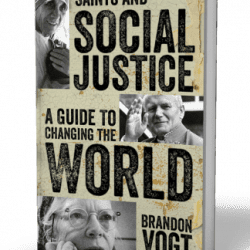Polarization in the US Catholic Church: Naming the Wounds, Beginning to Heal.
Edited by Mary Ellen Konieczny, Charles C. Camosy and Tricia C. Bruce
Liturgical Press, 2016
Universality – that is, small ¨c¨ catholicity – and, therefore, unity amid diversity are fundamental to Roman Catholicism. But in recent years, divisions around issues that are by now all too familiar – perhaps most notably, issues of gender, sexuality and authority – have rent the Catholic Church in the United States.
– Mary Ellen Konieczny, from the Introduction, page ix
Few Americans would dispute that we currently live in a polarized sociopolitical climate. Almost anyone who has suffered through watching the 2016 US presidential debates would probably agree that divisions between the ¨red tribe¨ and ¨blue tribe¨ are starker than ever. This book, Polarization in the US Catholic Church, poses a question to this divided society we live in. How can the US Catholic Church – whose teachings do not at all split neatly along political party lines – transcend these ideological differences? How can we respond with faith, humility and mercy to the divisions in our country and our world?
Coming out of the Polarization in the US Catholic Church conference held at the University of Notre Dame in April 2015, this volume contains articles by some of the foremost Catholic leaders, writers and scholars in the US today, like Notre Dame president Rev. John I. Jenkins, National Catholic Reporter journalist Michael Sean Winters, Christian ethics professor Julie Hanlon Rubio and religion professor Nichole M. Flores. The book begins with an introductory section that asks a question: is the US Catholic Church as polarized as it seems?
For some of the contributors, both in this introductory section and the book as a whole, the answer is ¨no.¨ Mary Ellen Konieczny, the volume´s editor, argues that 80 to 90% of Americans actually hold moderate positions on most ¨culture war¨ issues; however, because these ¨wars¨ are generally fought by elites in the public sphere, we can come to feel like we inhabit a more polarized world than we actually do. Hosffman Ospino describes the growing number of Hispanic Catholics as an ¨unheeded middle¨ whose (generally moderate) voices go unheard in debates about polarization. Speaking of millennial young Catholics and their current 50% attrition rate, Christian Smith argues that the problem is not polarization, but indifference and disengagement.
On the other hand, many of the contributors argue that we do indeed struggle with division. ¨I am a casualty of two Catholic culture war skirmishes – one in the ´60s, the other in the ´80s – and I have the scars to prove it,¨ says social worker Michael McGillicuddy. Likewise, Fr. Jenkins admits that at times, the language of the Church mimics the language of broader US culture in binding like-minded people together in opposition to a perceived threat or enemy: ¨The issue may be abortion, the plight of the poor, the nature of marriage, or the centrality of the family. In these and other cases, religion generally, and Catholicism in particular, gives a rich, moral framework to motivate te like-minded and to portray opponents as misguided people, threatening all we hold dear¨ (9). While Jenkins believes that religious leaders should be engaged in the world and speak to political issues, they must be cautious about how they do so: ¨Religious leaders…should think in terms of the cycle of salvation history and be concerned with building a church that witnesses to Christ as we wait for his return.¨
The second part of the volume, ¨Naming the Wounds,¨ includes four essays that seek to examine the roots of this polarization – whether real of perceived. In ¨Polarized Preferences, Polarized Pews,¨ Tricia C. Bruce examines the rise of ¨personal¨ or ¨ideological parishes. In the past, parishes were determined by geographical boundaries; one was expected to attend the parish in his or her area. Today, however, many parishes represent ¨elective affinities¨; they are formed by people who have come together due to a common liturgical preference, like the traditional Latin Mass, or an ideological stance, like liberation theology.
For Bruce, this is not necessarily a negative thing; she suggests that these parishes provide a home for Catholics who might otherwise be marginalized and add to the ¨rich mosaic¨ of the Church. At the same time, she does raise the point – which Michael Peppard echoes at the end of the volume – that by binding like-minded Catholics together, such parishes foster the same kind of divisions that Internet news ¨echo chambers¨ do: instead of forcing us to encounter those who are different, they allow us to isolate ourselves among the like-minded.
Similarly, in another essay in this section, Holly Taylor Coolman suggests that a lack of encounter with ¨the other¨ leads to a ¨loss of certain practices and skills: precise, measured debate; hearing and weighing the concern of the other; considering carefully arguments against one´s own position; imaginatively and creatively seeking strategies that break through a perceived impasse¨ (71). She insists that these skills are needed now more than ever: ¨We…lose the ability to argue with one another well…Our engagements become superficial and compative. Good conflict, after all, requires at leastwo things: that we are present to one anoher, and that we know that what unites us is greater than what divides us¨ (73).
The next section, ¨Assessing the Problem,¨ suggests some possible solutions for the issue of polarization. For me, the most interesting essay here is Nichole M. Flores´ ¨When Discourse Breaks Down,¨ which examines an issue that is often left out of the culture war debates in the Catholic Church: race and racism. Reminding us that ¨racism is latent in human hearts and social structures¨ and that ¨eradicating it thus requires confronting painful histories,¨(102) Flores calls for the creation of inclusive communities through what she calls ¨aesthetic solidarity¨: ¨engagement with aesthetic forms – broadly defined as symbols, art, narratives and performance – as a means of fostering communities committed to practical action in pursuit of justice and the common good (103).
Flores sees a link between liturgy and social protest as spaces where aesthetic solidarity can occur – not to ¨solve¨ racism but rather to increase empathy and build inclusive communities. This focus on aesthetics struck me as particularly original and rare in debates about polarization, and it reminded me of celebrated Israeli musician Daniel Barenboim in his collaboration with Palestinian-American cultural theorist Edward Said to build peace in the Middle East through the West-Eastern Divan Orchestra, which brings young Arab and Israeli musicians together. Perhaps this article appeals to my personal bias that beauty, more than truth or goodness, is what holds the most power to change the world for the better.
The final section, ¨Looking to the Future,¨ examines ways in which we might strive for greater unity in the Church. An essay by Elizabeth Tenety takes up an issue that is a running thread throughout the volume: the place of millennials in this polarized Church. Several authors comment that millennials largely demonstrated a lack of trust or interest in organized religion, a lack of knowledge of Church teachings, and a moral relativism that prevents them from taking a firm stance on issues. However, what millennials do respond to is Pope Francis´s call to show mercy. Earlier in the volume, Amy Uelmen remarks,
The pressure that young adults feel to keep a tight sense of control over all the elements of their lives seems to leave very little space for recognizing and processing the reality of suffering – illness, death, fears about violence in the world, or even more daily and mundane disappointments and failures. But in many ways, the capacity to look to this face of Christ can provide a deep source of perspective, hope, and deep connection with others (95).
Similarly, Tenety looks at millennials with compassion, tracing their skepticism of religion, distrust of authority, and reluctance to take a strong moral stance to a variety of phenomena the experienced growing up: the breakdown of families (they are children of peak divorce rates in the early 1980s), the trauma of 9-11, the priest sexual abuse scandal, and the era of mass shootings. Pope Francis has been well received by millennials because he sees the brokenness of the world and urges us to respond with mercy. According to Tenety, ¨The church can move forward when it learns from the life experience of Millennials instead of blaming them for not living up to some pristine ideal. They inherited a broken world, and they´ve learned to deal with complexities with compassion. For this generation, nonjudgmental solidarity is a way of life¨ (118).
Building on this issue of millennials in the Church, another great essay in this section tackles one of the most contentious issues: the pro-life causet. Many authors in this volume suggest that polarization in the Church will be transcended when we see parish respect life committees and social justice committees frequented by the same people, when concern for the undocumented meets concern for the unborn. In ¨Polarization and Abortion: Living Out Our Pro-Life Beliefs,¨ Erin Stoyell-Mulholland argues that the pro-life cause must be pursued not with judgment, anger and fear, but with mercy and kindness. ¨When speaking out against abortion turns into an ´us versus them´ mentality, you lose the interest of young people…But when we talk about supporting and loving a pregnant woman and her child, young people want to get involved. When the message is a message of love, not a message of judgment, people are drawn to the pro-life movement¨(124).
On the whole, this is a very insightful and hopeful volume, truly relevant to the concerns facing the Church today. It calls us to remember that our similarities are greater than our differences, that as Catholics we truly are a big-tent organization in which, as James Joyce put it, ¨Here comes everybody.¨ I commend the conference organizers for starting this dialogue, and as a reader, I hope to see it continue.
If this work is to be taken further – and I hope it will be – I could see it going in two directions. For me, as comprehensive and thought-provoking as this volume is, it still seems to be a book by and for elites – nearly all the contributors are high-profile clergy, priests or journalists. I would love to hear some voices from the pews – voices of parish trustees, for example, or church musicians, or parishioners who devote their time to serving on parish councils and leading committees. Moreover, I would like more exploration as to ways in which the Catholic Church can respond not only to the polarization within its own membership, but in the wider world. I would truly appreciate a follow-up volume on such issues as interfaith dialogue, or the Church´s response to a greater ¨culture war¨ that seems to be developing between religiosity as a whole and secularism.
As an older millennial, I found the discussion about those Catholics in my age group to be quite accurate. I have often felt discouraged when faced with the absence of Catholics in my age group, but the discussions in this book give me hope that the Church does have a future renewal ahead. Meanwhile, as the political polarization in the US continues to divide so many, I take comfort in these words by David P. Gushee, a scholar who was raised Catholic, became a Southern Baptist, and then eventually found his way back to Catholicism:
Scanning the entire Christian landscape, I find in the Roman Catholic Church one of my only sources of hope. Catholicism has a long historical memory, so it knows better than to identify current circumstances with eternal truth. It is international, so it has resources for getting beyond parochially American categories and patterns. It has resources in Catholic theology and ethics that challenge simple left/right binaries. And it appears impervious to a full-blown institutional left/right split as might happen with a Protestant congregation or denomination. This means that those American Catholics leaning left, leaning right, and leaning center must continue to relate to each other, as sisters and brothers in Christ, like it or not. As they do, they have the broader resources of the Catholic tradition available to point them to a path of Christian integrity and unity (87).















